A.C. Rodríguez's Blog
May 9, 2025
invisibility in "jauría:" the call for colombians to safeguard creativity
I'm not going to talk about Pope Francis, may he rest in peace, because the topic of his life and death are very personal to me. I'm also avoiding talking about the conclave and the election of Pope Leo XIV because all that can be determined by the AI if and when it wants. They're my emotions, they're my perspectives, and what I care to write about is art. If and when the Church comes up, I'll mention my thoughts and feelings.
So, I'll continue with Colombia and films/series.Storytelling
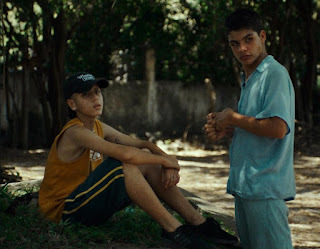
"La Jauría (The Pack)" (2022) written, produced and directed by Andrés Ramírez Pulido is a film not given over to plot. It's about characters, but, it's also not necessarily about character development. I regret putting "Knight Stalker" on The Story Graph for the reason that pie-charting a work of art around subjects like "plot or character driven?" / "strong character development?" / "flaws of main character a focus?" reduce storytelling to the typical Western framework of what a story should be about.
Not all stories have characters that need to be developed. Not all stories need a plot or discernable characters. Not all stories are about flawed characters nor about archetypes. In fact, stories can be pretty nuanced. Aren't the best stories nuanced? The best stories are weird. That whole Joseph Campbell thing is not necessarily how the rest of the world tells stories.
Some stories are told through symbols and allegories pointing towards yourself or me or the world or all three. Some stories are aware of their own purpose and let you know (or don't). Some stories tell stories in ways that make no sense, and are mostly vibes and atmosphere. Come on, this is art.
So, "Jauría" is not a pie-graph type of film and that's why it's great.Land & History
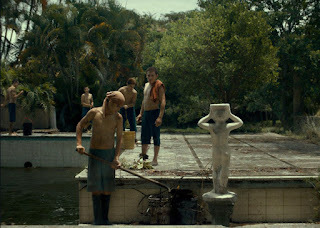
The film was nominated for the Caméra D'Or at Cannes. And, yes, I'm aware that I've already mentioned I have problems with Cannes, but, it's still good exposure. It won the Critics' Week award which is Cannes' way of honoring new talent. And, of all the reasons why the film is so meaningful to me, the first is because it was filmed and takes place in the region of Colombia where my grandmother and her family are from, which is called Tolima. This area is a very fertile area, but, due to deindustrialization has decreased its GDP in agriculture.
[AND THAT IS WHAT PRES. GUSTAVO PETRO HAS BEEN ASKING CITIZENS AROUND THE COUNTRY TO GO OUT AND PEACEFULLY PROTEST FOR: FAIR WAGES, RIGHTS FOR FARMERS, AN END TO THE CYCLE OF CRIMINALITY ON THE PART OF THE POOR ONCE GIVEN THE CHANCE AT DIGNIFIED WORK. Because, the cycle might just be rich's fault, who knows.]
It's mountainous in parts, its tectonic plates are from the Triassic period, so, 220 million years old. It's rich in emeralds.
Very tragically, forty years ago, and my family remembers this because it happened close to the old land my great-grandfather owned, a stratovolcano called Ruiz erupted and killed twenty-three thousand people by lahars most of whom lived in a city called Armero. This was a thing worse than a horror story and shocked the world. Several factors, including greed, prevented people from being evacuated, including badly drawn and distributed evacuation maps, and politicians telling people there was nothing to worry about despite all the signs. Like the Titanic. A storm was raging so strongly, apparently, that certain electric signaling was lost and with no radar plus the noise of the storm no one expected to be instantly killed. During rescue efforts, there emerged the infamous case of the ten-year-old girl Omayra Sánchez, who remained alive but half-trapped in water with no means to escape without leg-amputation, for three days until her death, while rescue workers and journalists kept her company. As is so mysterious regarding children, Sánchez was cheerful and quite accepting of her impending end. A French photographer won the World Press Photo of the Year for his picture of her, for demonstrating the effects of what it is for a government to mishandle emergencies.
So, for Colombians, Tolima's land is known for its extraordinary mystery, whether in creativity or in destruction. Ramírez Pulido, a Bogotá native but who spent over seven years in Tolima, will use this in the film.
Remember my last post about "La Violencia"? After Violencia in 1958 (my grandparents were already in the US and my extended family in Bogotá) the Colombian government established a National Front which mandated that Conservatives and Liberals would share congressional power and would alternate presidencies. How can you control something like that? thought many leftists and revolutionaries. Part of the formation of the infamous Marxist guerrilla army Fuerzas Armadas Revolucionarias de Colombia (FARC) included the establishment of a kind of commune called "Marquetalia Republic" which claimed certain areas of the departments Tolima, Cundinamarca, Huila and Cauca within which leftist peasants and guerrilleros lived as though the National Front held no weight and within which rebellion could and did indeed brew.
Once the National Army dismantled this republic in '64, FARC officially formed and lots of horrors ensued. FARC dismantled in 2016 in Havana. With fifty-two years of trouble, obviously it had quite the run. Its history with all its conflicts and its ideals and its alliances is all very controversial. But, that's history that would be too cumbersome to get into, even though I'll refer to some of it later in the post.Natural Law
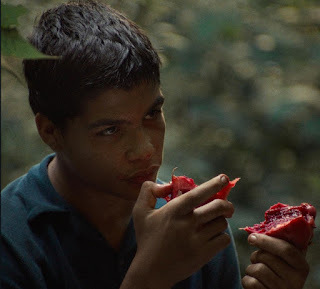
Now that we know the setting, we can understand "Jauría" and how it gets away with many mysteries. Its premise is around two teenage boys. One is Eliú Méndez (Jhojan Stiven Jiménez), hardened, sad, but with deep understanding behind his eyes. The other, just as hardened and sad but far more nihilistic, is Maicol Andrés Jiménez (whose name is the same actor's name) going by the nickname El Mono, which is a term meaning one of two things, or both: "blond," which even though he's technically not he's still light-eyed and light-skinned and that counts as blond in Colombia; or, "monkey." Eliú and El Mono stop a motorcyclist, kill him with a machete, ride out on their own motorbike with his body to hide it until whoops it falls off, and drag it to a cave (at least we think they do; the film isn't linear and it isn't clear what's real or imagined) which has an opening above some corner where sunlight may pour through. We're never told how the boys are discovered to have committed this crime, only that they are indeed discovered. They're each sent to separate "rehabilitation centers" around Tolima. Despite they're initially not being sent to the same center, they're nevertheless soon reunited in the place Eliú originally ended up in.
Why the pair killed this man is mysterious, as it's only the district attroney who reiterates to us what Eliú's told him: that the latter was seeking to kill his own father but accidently killed someone else. We never learn the truth. As the attorney asks Eliú at the crime scene, "how can you not realize that the man you're killing isn't your father?" Take that as you will. Why did Eliú want to kill his father? We're given dialogical clues that his father abused his mother and raped him, but, the language around the matter is purposely vague. Now, the man Eliú and El Mono actually killed, named Emanuel José Macías (played by none other than the director himself, which leaves a lot to ponder) had been, according to his nephew, a man whom in his youth had lived hedonistically until he apparently encountered someone or something he called "The Invisible" and then gave up hedonism and lived a simple life; for that reason, he was called "El Invisible." Well, he is pretty invisible, as the main thrust of the film is about characters, including Eliú and El Mono, wondering why there's no body in the cave. As I mentioned, was there ever a cave? Hey, was there ever even a body? Eliú and El Mono have already brought the detective back to the cave twice and insist that it's where they left El Invisible, under the ray of sunlight, and a flashback does indeed show the boys leaving the body in that very same cave.
Come now, my good people, you know the world, you know our philisophical-religious framework: who else's murdered Body was placed in a cave and then disappeared from it? ;) And the character's name is "Emanuel," of all names.
Ramírez Pulido throws into this film a character named Álvaro (Miguel Viera), a middle-aged man, who despite his own criminal background is serving time by mentoring the boys in this center and providing psychological and physical therapy. Álvaro claims he himself was abused by his father, and, in that sense, is able to connect to the young men. They're all either fatherless or, like Eliú, have been abused by their fathers and taken after them. Some have killed, and all have stolen and participated in drug trade. The man frequently compels the seven boys to, while they're not cleaning an abandoned mansion's pool (which we realize later is mere slave labor so that some contractor doesn't have to pay), release their anger through psychically connecting to the earth around them. It's what keeps him sane. Álvaro's foil is the guard named Godoy (Diego Rincón) who insists that Álvaro's "softness" will rot the boys rather than rehabilitate them; castigation, mortification, humiliation, those methods are how you get people to stop doing bad things, because human nature is indelibly f&cked. Some kids just need to be frightened more to stop them from being criminals, but, underneath, we're all like the savage nature around us, like the volcano, ready to spew and kill at any moment. We have to clean up all this filth from the pool, cut down trees, and, because the film's Spanish title translates to "pack of hounds" we're to use our keen awareness of evil to chase it down and kill it. Godoy loves his truck whose backseat is a kind of pen into which he chains the boys when they must travel, blindfolded. In fact, the boys are usually always chained, and one time El Mono mysteriously escapes just to be hounded down by one of the actual dogs. Some rehabilitation.Hegelianism, Marxism, City of God //Where Perhaps Paradise is Much More Like an Unpredictable Garden

Things spiral in the film. It's worth watching. The cycle of violence spins on. Vengeance, betrayal, corruption, hedonism. Until it doesn't. Until Eliú goes through Hell, goes through the cave with the light, but manages to come out alive and somewhat unscathed and is even encouraged by his brother back in the village to carry out what had been his main mission: to kill his father. Eliú breaks the cycle and goes off to work picking bananas.
That last image of him on the back of the banana truck brings with it a deep meaning, as I can't explain at length but involves the US' capitalist imperialism in the multinational Banana Wars of the turn of the century, the abuses of the United Fruit Company (now Chiquita) all over the Caribbean and specifically in Colombia's 1928 Banana Massacre of workers on strike for basic rights. According to US officials and the company's reps, these strikes were "communist" and "subversive in tendency" and here we are nearly one hundred years later, "One Hundred Years of... Fill In the Blank." Invisibility, maybe.
So, my take is that Colombia in this post-FARC era and still struggling with narcos, has finally elected a president who despite severe opposition is encouraging what FARC originally stood for but went about in an explicitly violent way. Petro was, after all, a prominent member of the second largest guerrilla group after FARC, M19, which was urban and eventually demobilized in order for its members to politicize. Coincidentally (isn't timing a funny thing in this country?) the most brutal of M19's acts of terror was to seize the Palace of Justice and hold everyone in the building hostage, while the President Betancur refused to cooperate and demanded that the Army use force and kill hundreds, and this happened exactly one week before the Armero volcano mass deaths. November 7th vs. November 14 of 1985.
Things come around in mysterious ways because we humans with our reason and our wills are quite mysterious, more mysterious than volcanos and mountains and glaciers and storms. The idea of this film is, though, that if and when you resurrect, you tend to your nature as though it were as bountiful as a fecund harvest. You need to separate wheat from chaff, yeah, but, Colombia can find peace without the cycle of violence and radical thought.
OK, GIVEN THE APPROPRIATE END OF THIS POST, I WILL OFFER UP THAT YOU READ LAUDATO SI' BY THE LATE POPE FRANCIS FOR AN UNDERSTANDING OF ECOLOGICAL SPIRITUALITY AND HUMAN DIGNITY. It's most beautifully written. I miss him and very many others too, but, I have hope in Pope Leo XIV's theological background, his decades spent in Peru among the pueblo, denouncing both the Shining Path and Fujimori (extremes of left and right, respectively), advocating for synodality and social justice especially in denouncing Trump and Vance, and being Augustinian although I've spent a long time fearing the Augustinian charisms for their tendency to produce mad minds like those of Martin Luther. I had a feeling God's plan was for the Church's leader to be yet another Latin American. Yeah, I think he's more Latin than US American, but, we'll see.
March 1, 2025
the ugliness after 25 years: scene analysis regarding warfare
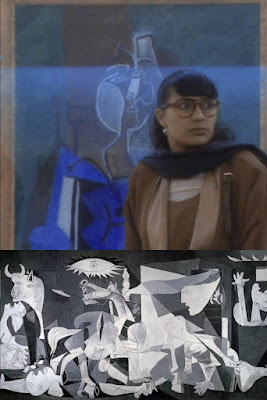
There's a scene in the many-times-over spun-off and remade "Yo Soy Betty, La Fea," that Guinness-record-holding Colombian telenovela written by Fernando Gaitán which aired from 1999-2001, that seems so out of place it can make you wonder whether the entire 150-hour-long saga is more an allegory for something large-scale rather than an oftentimes-goofy melodrama about a nerdy unattractive secretary playing cat-and-mouse with her narcissist boss at the offices of a fashion house.
The scene is found in what's originally the 168th episode, a twenty-two-minute run where now-streamable episodes have been edited together to be between 45 minutes to an hour. The episode aired on the 16th of June 2000, and the edited version you can watch is the 68th episode entitled "Entre Cuadros de Picasso." The character Catalina Ángel (played by Celmida Luzardo), a publicist and friend to many of the series' characters, is explaining a replica of a Picasso to a group of secondary characters who are all gathered at El Museo Nacional in Bogotá, which was once a prison modeled in the style of a panopticon. I'll get to that. Before Catalina begins her explanation of the replica, our titular character Beatriz Pinzón Solano (Ana María Orozco) has excused herself to one of her friends and coworkers to go clandestinely meet her employer and lover, CEO of the company Ecomoda, Armando Mendoza (Jorge Enrique Abello).
CATALINA
Vengan, les quiero mostrar este cuadro. Es tal vez el cuadro más famoso de Picasso. No es el original, obviamente. Es una reproducción en miniatura; el original es más grande que esta pared. Simboliza la violencia.
Come, I'd like to show you all this painting. It's probably Picasso's most well-known painting. It's not the original, obviously. It's a miniature reproduction; the original is larger than this wall. It symbolizes the essence of violence.
During the line beginning with "the original..." the camera cuts to the miniature of Picasso's 1937 "Guernica." And then, while Catalina says the line, "It symbolizes the essence of violence," the camera cuts to two women climbing the stairs to the museum. It's dark but perhaps not late: nighttime falls year-round in Bogotá at around 6 pm. The women are arm-in-arm and walking hurriedly, with determination, with trepidation, as well as with a nebulous righteous anger. It should be watched to be best understood. The women are two important characters in the series, the first actually being a deuteragonist: Marcela Valencia (Natalia Ramírez) and Patricia Fernández (Lorna Paz Cepeda). Marcela is a shareholder and vicepresident of sales at Ecomoda, one of its heirs as her deceased father had started the company (along with Armando's father, Roberto) as well as Armando's fiancée. Patricia is her long-time friend, currently working as executive secretary at Ecomoda though she's overpaid and underqualified. The women hurry toward the entrance to the museum as the line is said with tense music in the background. The audience at this point in the saga understands they're there on invitation from Catalina but also due to an intuition that Armando is indeed meeting a lover there, who neither Marcela nor Patricia know to be or even suspect is Beatriz.
"La Violencia" is a code that would not have gone over the head of any Colombian. Explaining that as well as what it could mean for this television drama that portrays comparatively mild physical violence but an enormous amount of psychological violence and explicit economic warfare, is my task for this post.
Background: Oligarchs as Economists
Beatriz, called Betty, lives in a humble neighborhood in Bogotá, the only daughter of a controlling father Hermes Pinzón and an enabling mother Julia Solano. Betty and her best friend Nicolás Mora (Mario Duarte) are relatively young economists, having earned degrees with honors. Colombia, of all Latin America, has the most universities after Brazil and Mexico and two rank in the top 15 in Latin America. LatAm is growing, she's still young and volatile and confused in identity: the planet's biggest bully is directly north of us, cut us some slack, OK? Anyway, Betty and Nicolás are flukes: they're not so much "ugly" in appearance as much as "ugly in appearing poor," out of touch with superficiality, unconcerned with social decorum and unseemly in their old-fashioned ways. Awkward nerds, you can say. Nicolás even exhibits traits that, with the awareness now twenty-five-years later, might put him on the autism spectrum. Nonetheless, they are genius financers, and they are too self-conscious to have the ambition to aim for employment that would suit their credentials, aware of their unseemly looks and weird personalities in a culture built on collective uniformity.
Betty tries and succeeds to land a secretarial position at Ecomoda. Very Devil-Wears-Prada, but, sorry, "Betty" aired and was a worldwide phenomenon before that novel was even written. The saga of the telenovela begins with the retirement of Roberto Mendoza as CEO of Ecomoda with his only son Armando being named the new CEO to the chagrin of Daniel Valencia (Luis Mesa), Marcela's brother and fellow heir to the Ecomoda dynasty and obviously one of its shareholders. Armando is not a good economist. Nonetheless, Marcela, being in love with him, supported his being named CEO and not herself or Daniel, once again leaving Ecomoda's steering wheel in the hands of a Mendoza after the Valencia patriarchs' premature deaths. Betty becomes Armando's right hand and dreams of him like a scullery maid would a prince, while Armando uses her infatuation with him to manipulate her into covering up personal and, more importantly, professional mishaps. Armando offers Betty capital to begin a shell company called Terramoda which will rescue Ecomoda from the debt towards banks and creditors, as well as prompting her to doctor the numbers for Ecomoda's shareholders so that no one learn about Terramoda. Armando also insists Betty does what she thinks best with the capital to make it grow: Nicolás ends up astutely investing in good stock. Upon the suggestion of another shareholder, Mario Calderón (Ricardo Vélez), Armando seduces Betty and begins a romantic and sexual affair with her so as to ensure her unflinching loyalty.
How Betty isn't the wiser to Armando's and Mario's schemes speaks to how naive she is to the core corruption of the wealthy. Think about the theme of the film "Parasite." The shareholders and wealthier employees within Ecomoda, including and especially the house's lead designer Hugo Lombardi (Julián Arango) and Marcela due to Betty's obvious loyalty to Armando, are so explicitly cruel and demeaning to Betty for the unforgivable crime of being cringey-at-first-glance and overly nice and lightning-quick-smart that the series is often painful to watch. While at Ecomoda, before and during the affair with Armando, Betty just takes the shame and abuse; she's used to it, and her intellect if not her social affability wins out over most other people's. Unfortunately, her resulting pain has to manifest somehow. It does in the form of dysmorphic break from reality into escapism where Betty lives in a kind of dream state. Standing apart from her own sexuality enables her to have the sappiest and most fantastical medieval-type chivalric fantasies. The kind featured in Mexican telenovelas. Magical realism, some say, began in Colombia; and, Mexico is always taking our best telenovelas, including "Betty" and Gaitán's other classic "Café con Aroma de Mujer" and remaking them. No offense, Mexico, I love you, but, please bring back Frida and Diego and the Golden Age of your cinema and we'll bring back Gabo, Botero and Gaitán. Let's make a truce about that and to no longer produce Karol Gs and Peso Plumas, good God.
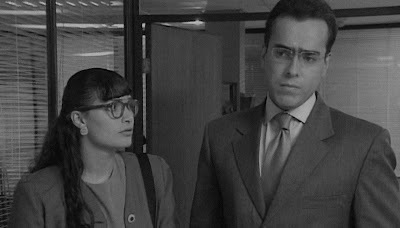
Anyway, Armando claiming he's fallen in love with Betty creates this sense of euphoria in the woman where she's willing to do anything for her man, while Armando's conscience does begin to rear its ugly head. Armando isn't used to women like Betty, physically or psychologically; she is the loyalist person due to him regarding her as worthy and intelligent and calling her beautiful even if he doesn't mean it at first. They say women become more beautiful the more they're loved. Armando does fall in love with Betty and does come to see her as someone fragile and broken and yet still strong and upright. Side note: that's the definition of the ideal Hispanic wife, by the way. Yeah. We're all fragile and broken, we're all Lloronas, but because we remain strong in our loyalty to our man and follow the social codes of remaining humble against any abuse, we exemplify redemption from being born with the curse of Eve to becoming more like the Virgin Mary. It's a concept made up by men thinking God is Father-God with a beard and a booming voice like in the Old Testament, calling Israel a "whore" for experimenting with the worship of other Near Eastern gods. Truth is that Jesus, perfectly God and perfectly human, is actually way more feminine than masculine and praises women more than men. But, I digress.
Surprise! Betty finds out Armando's romance is a ruse through a mistake on Mario's part. She enacts the first out of two revenges: Betty tortures Armando into madness and alcoholism, dangles the wealth her and Nicolás have accrued from Terramoda in front of Ecomoda, and eventually exposes to the shareholders how Ecomoda is entirely indebted to Terramoda before leaving for good. Catalina offers Betty a chance to be her assistant during the Miss Colombia pageant being held in the lovely colonial Caribbean-shored Cartagena de Indias, and, there, Betty undergoes a physical and spiritual transformation and meets happy laid-back people in the tourism industry. Back in Bogotá, Armando and Mario have had to renounce Ecomoda. The former becomes suicidal out of guilt and shame and loss. Second revenge, Betty returns to the capital a beautiful girlboss agreeing to help Ecomoda by becoming its CEO and an enlightened oligarch by means of a Cinderella story-arc.
Boo, Betty eventually marries Armando, having forgiven him. The finale clocked in at eleven-million views, extraordinary for its time. The series isn't about poor people having rights by merely existing; it's about poor people waking up to being industrious and elegant with Judeo-Christian values and respect for the rich. In my opinion, that's genuinely why it was so successful. It exemplifies neoliberalism in the 90s, and Colombia, unbeknownst to ignorant people, has a middle class unlike many of her Latin American neighbors. Rumors are that the ending was forced by the producers, as Gaitán had wanted Betty to return to Cartagena and work with a Prince-Charming-type Frenchman she meets there Michele Doinel (Patrick Delmas) while Armando would have committed suicide. But, that would have been too dark for the public, obviously, and its moral would have been that financial and personal success lie in ditching the old Catholic oligarchs for entrepreneurship in tourism and travel and gentrification of historical areas.

A clear delineation exists within the series. There are those belonging to old-money, who are traditionally elegant and chic, educated in Catholic conservative universities, a.k.a. the shareholders of Ecomoda, as if they were noblemen in a feudal caste. There are those who are underpaid and overworked belonging to the lower middle class, not groomed to aim for a higher class, who are expected to be picked on and are therefore resentful if still funny and jovial. The group Catalina is speaking to about Picasso is the group of underpaid and lower-middle-class secretaries from Ecomoda who've been called "el cuartel de las feas" or "the ugly women of the barracks." I don't know if the "Squad" led by AOC (whose name resembles mine and ironically we're both from NY, but she's a Nuyorican not a Colombiana and that makes a difference), ever knew about this series. But, it's the same idea, though there's absolutely no comparison as the Squad are the most non-jovial people in Congress. I'll take MTG over them because MTG believes in her vote for the Iron Dome while AOC is a crying hypocritical coward who voted "present" and then parties at the Met Gala in a dress reading Tax The Rich.
"El cuartel" plays a pivotal role in providing much-needed comic relief as well as always supporting and encouraging Betty to build her self-esteem. Patricia, on the other hand, is employed merely through the demands of Marcela so as to spy on Armando's womanizing, is a superficial gold-digger living as though she's upper-class without being able to afford it and subsequently finds herself the butt of everyone's jokes. Patricia's false claims that she's completed six out of ten semesters in a university called "San Marino" which doesn't exist in Colombia but obscurely in northeast Italy, exemplifies the extraordinary lying people from this culture will resort to so that others are obligated out of social code to accept regardless of whether they're aware of the lie.
The laborers in the warehouse of Ecomoda? Nobody cares, none of them ever say a line except to collectively cheer that Armando and Betty both run the company together. Way to go, producers. With that said, let's move to the history of this classism in Colombia and the nearly-eighty-year conflict and asymmetrical warfare begun with a period called "La Violencia," as well as the irony of where the Picasso exhibit was being held which was in a panopticon prison turned into the National Museum. Colombia is a place of extremes.
"La Violencia" and the Panopticon-turned-Museum
In 1948, in a funny coincidence with names, the candidate for presidency running as a leftist was assassinated, and his name was Jorge Eliécer Gaitán. Same surname as this series' writer. Gaitán's assassination instigated a collective madness which swept the country, beginning with killings and rioting in Bogotá which left thousands dead, with what's called "El Bogotazo" and spreading to different regions. Some of the world's most depraved and disturbing tortures and killings were recorded and analysts are still thinking about what happened to the proletariat, the farmers and laborers and leftist supporters, to so insanely attack conservatives and the Catholic Church and experience retaliation. Some say it was an op; Fidel Castro was there for the assassination. What was he doing there and then? Ten years of this mad terrorism has been named, appropriately, "La Violencia," taking the lives of about 200k Colombians. My grandparents fled this madness. It's in my DNA. Why do you think I write about the things I do? I'm offering it to God and to you so as to heal the wounds, because we are more than assassins and rapists and general savages; those who are were made that way and we need to heal and not be further beat down.
Let's do conspiracy. The National Museum of Colombia was a prison in the style of a panopticon, built in 1872, the largest in the country. In 1946, a new prison called La Picota was installed with the plan to move the prisoners out of the Panopticon so as to prepare to inaugurate the building as a museum on the same day Gaitán was murdered and the riots began in 1948. And, so, the museum opened a few months after Gaitán's assassination and we have to wonder about the politics of that museum and its original intent. Anyway, prisoners of La Picota are a mix of corrupt politicians, narcos, and members of leftist guerrilla groups such as FARC (which supposedly dismantled in 2016 in Havana of all places), M19 and ELN. Unlike the Panopticon, these prisoners aren't being tortured by means of having guards be able to look in on them at any given time and experience perpetual violation of privacy.
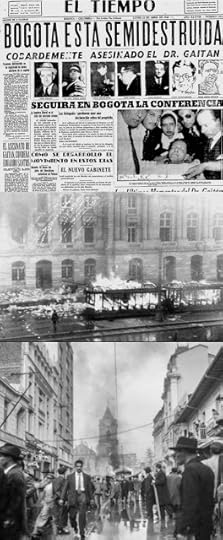
The Museum can be said to be haunted. Its aim was and continues to be the telling of Colombia's history. One if not the most famous Colombian visual artists, featured on the Champs-Élysées and on Park Avenue in my hometown New York City, is Fernando Botero, who, peace to him, was known for reproducing famous religious and political paintings in a stacked and fat style for humor and critique. Personally, I admire his work depicting the Abu Ghraib tortures. Either way, the disturbing history of the building and its coincidental move toward becoming a museum congruent with "La Violencia" works almost too perfectly with the scene in "Betty" at the center of this post.
Obviously, the Museum was indeed hosting a Picasso collection during the filming of "Betty" and Gaitán (that name!) took advantage of the occasion to create several episodes taking place within the building and regarding the different artwork. Catalina speaks to the cuartel and to Hugo and others of Picasso's womanizing, which the characters joke resembles Armando's reputation. Darkly, she mentions that Picasso's last and most loyal woman ended up committing suicide, which might just be a reference to Betty's transformation where she allows her masochistic personality to die and she is reborn into a new personality of a woman of grace and dignity. Armando himself will soon become violent and suicidal like Picasso when Betty finds him out. So, Marcela and Patricia hurrying into this prison-museum to try and "catch" Armando with a mysterious lover while Catalina speaks of "La Violencia" is no coincidence, even if it's in reference to the essence of violence in Guernica. Marcela and Patricia and Armando are oligarchs, Armando and Marcela being heirs to a wealthy company which might as well be a small feudal kingdom, and they would be considered the enemies of the rioters during the Bogotazo. Or, perhaps, if we want to be conspiratorial, we can say the oligarchs themselves began the rioting and violence to blame it on the proletariat. The forty-second scene is loaded with mystery.
Before I move to Guernica, though, I'd like to point out my translation of "La Violencia" to "the essence of violence" rather than just literally "the violence." Spanish is a language rooted in Latin as well as Arabic and of course has elements of ancient Greek and Sanskrit. Like other Romance languages, nouns or subjects have either masculine or feminine connotations, or sometimes but rarely both. And so nouns have this "essence" that demands the article "el" (for masculine) or "la" (feminine). In English, it would sound strange to say "Ah, long live the love," where in French everyone says, "Ah, vive l'amour," and in Spanish, "¡Viva el amor!" Therefore, "La Violencia" seems better translated as "The Essence that Is Violence" as awkward as that would sound. It does demonstrate the nature of the language better.
Guernica and Genocide Against Leftists
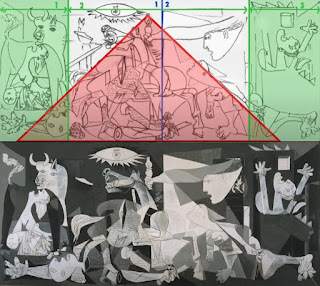
At this point, I'd like to give the background of the painting. In 1937, eleven years before the Bogotazo, the Basque region of Spain was a stronghold for leftists opposing the Franco regime in Spain as well as fascism in general, and the Nazis decided to annihilate the city with two hours of bombing. Most of the city's men were away fighting. All infrastructure leading out of the town was the first to be destroyed and so no one could escape. German planes dropped bombs weighing 1k lbs and deployed about 3k two-pounder aluminum incendiary projectiles. Fighters mowed people down with machineguns from the planes. Nazis slaughtered about eight hundred civilians.
Look, my first piece is about a merciless serial killer and rapist. I've had to think about these things a lot. I think about Palestine every day, a lot. I think of Sudan. I think of Latin America where really dumb people from the US don't realize that innocent people are being threatened, tortured and killed against the right-wing narcos and are looking to escape across the border so they can live. I think of places that the mainstream media will not even tell us about. And, for creatives, we feel things strongly and our responsibility is to show you what impacts us while not doing it to harm you or shock you into feeling helpless. I carry this extreme violence and genocide of my race and my distant relatives within me; I believe in genetic memories. I don't like talking extensively about my personal life but it is obvious that extreme violence is important for me to address in art. I'm curious as to how people can become so numb to it. It is unbelievable, and so that wonder at how cold humanity can be is a contrast to the lifeblood of my art and about my countrymen and women suffering for eighty years.
So, Picasso was in Paris during this slaughter of Guernica and he put his heart and soul into this oil on canvas piece that is 11 ft. tall and 25 feet wide. Parisians didn't like it on first display. The artist paid for it to tour parts of Europe and then America, first on the west coast and then in NYC, then to Milan, Brazil, back to USA to Chicago and Philly and again to NYC where it stayed in MoMA for a while and served as an excellent reference piece to other pieces about Vietnam. Picasso refused to let it go to Spain until he considered Spain a safe and sane republic free of fascism. He passed away in '73 and two years later Franco died. MoMA didn't want to give up the painting, arguing that Picasso considered that as long as Spain continued honoring its monarchs it wasn't free. Finally, with enough money I suppose, they conceded and the painting went to Madrid's great Prado, but then it was moved to the Reina Sofía which is for twentieth century art. Basques have advocated that it be kept in their land. I'm personally with them. The UN has a tapestry of the painting in its headquarters in NYC. The Bush administration had it covered while it decided to go to war with Iraq. Ha.
This video I'll post here points out a lot of beautiful aspects of the painting that I couldn't really put better myself, with regards to symbols. So, I'll make the reference to the video. I particularly like the monochrome aspect of the chaos as it leads the senses to consider newspaper. Again, a kind of desensitizing. A way of learning about the horrors that are happening far away that you feel helpless against except to portray the lack of conscience.
Conclusion
And, so, there's a lot to "Yo Soy Betty La Fea" whether consciously written/directed or not. I don't care about its silly spin-offs and remakes because the original captured something unrepeatable and something that still carried darkness reflecting the ongoing civil unrest of Colombia: the background fear of crime, leftist guerrillas, paramilitaries, narcos, and also the more explicit neoliberalism and the oligarchs owning the media, the explicit superficiality, the beauty standards, the misogyny, the mental illness and spirituality, the consequence of lies. But, it's my family's country and I consider it my home. I'll fight for her 🇨🇴. And I honor her ability to make great art that is being occulted by Shakira, Karol G, J. Balvin, Maluma, and Kali Uchis; we can do better, because we already have.
February 23, 2025
fools win

I'm getting to the post I said I'd do. It's about "Yo Soy Betty, La Fea."
I leave this excerpt from "Une Saison en Enfer" or "A Season in Hell" by Arthur Rimbaud: "Délire II: Alchimie du verbe" trans. by me.
À moi.
L'histoire d'une de mes folies.
Depuis longtemps, je me vantais de posséder tous les paysages possibles, et trouvais dérisoires les célébrités de la peinture et de la poésie modernes.
J'aimais les peintures idiotes, dessus de porte, décors, toiles de saltimbanques, enseignes, enluminures populaires ; la littérature démodée, latin d'église, livres, érotiques sans orthographe, romans de nos aïeules, contes de fées, petits livres de l'enfance, opéras vieux, refrains niais, rythmes naïfs.
Je rêvais croisades, voyages de découvertes dont on n'a pas de relations, républiques sans histoires, guerres de religion étouffées, révolutions de mœurs, déplacement de races et de continents ; je croyais à tous les enchantements
My turn.
A tale of one of my idiocies.
For a while, I bragged of possessing every possible landscape, and found paltry the celebrations of paintings and modern poetry.
I loved stupid paintings, door hangings, décors, circus backdrops, signs, popular lighting; outdated literature, medieval Latin, badly-spelled erotica, geriatric novellas, fairy tales, little kids' books, old opera, nonsense jingles, innocent rhymes.
I dreamed of the Crusades, voyages where you'd discover you have no relation to anyone, countries with no history, smothered religious wars, moral revolutions, racial and continental displacements: I believed in all kinds of magic.
Yes, I too believed in all kinds of magic, M. Rimbaud, and I love us best when we do. Be the cringe rather than spend all your time dodging it for the sake of pompous idiots, it's got that unbeatable power of the (un)holy fool.
February 11, 2025
of beasts and bodhisattvas: kore-eda's "monster" isn't as 'queer' as 'angelic'

From "Monster (Kaibutsu 怪物)" dir. Hirokazu Kore-eda
This is not the post I've been planning on for some time, but, I'd like to post it and save the other for next week or the following. My Storygraph Giveaway ends on the 19th and with certain politics here in USA I do have a review about an artwork that speaks more closely to my own home and my art (current and as-yet-unreleased) than this one. Surprisingly, it's not the humiliating-to-Latin-Americans 2024's "Emilia Pérez:" I don't want to talk about that egregore, even to criticize, though it's tempting; I don't want to feed it. No, I've been planning a review of an old kitschy Colombian artwork, nothing to do with narcos and exploitable violence, in a funny format that's made a come-back. But, I do want to make this post about "Monster (Kaibutsu 怪物)" now. This is also an important topic.
Introduction
It's award-season and MUBI offered me three months of subscription for $1 each month. Naturally, like any film lover, I took advantage of the offer and immediately watched Tarsem Singh's 2006 "The Fall." For years, there'd been no legal streaming of the film on any platform in the US and no availability of a reasonably-priced DVD or Blu-Ray on any legal platform. Notice I said legal, twice. The sumptuous and somewhat problematic film deserves its own post, but, that's not today's nor next post's business.
I also watched a film on MUBI I'd been looking forward to seeing by one of my personal favorite directors, Hirokazu Kore-eda, his 2023's "Monster." My take: amazing, perfect, poignant, beautiful. Perhaps it's not as gut-wrenching as 2004's "Nobody Knows" which I prefer over the Palme-D'Or-winning 2018's "Shoplifters" but, that's just me. Perhaps it's not as explicitly Buddhist as the shocking 2009's "Air Doll". Nor as meta as the fabulous 2019's "La Verité" with the likes of the greats Catherine Deneuve, Juliette Binoche and Ethan Hawke. Nonetheless, it's as hypnotic, engrossing and relevant as Kore-eda's best. So, what's the thing I'm gonna talk about? Well, speaking of Palm awards at Cannes, the film's screenplay written by Yuji Sakomoto (not Kore-eda himself, which is out of the norm for his films) won Best Screenplay at the festival, and the film won... the Queer Palm. TOMARE! JAPANESE FOR "STOP"! No hate. Want proof? Go to my Goodreads Author profile and look at the blaring category "Influences." See the first two authors? Not the third and fourth. The first two influences on my style of writing: Arthur Rimbaud and Ocean Vuong. Now, look those artists up and then come back and tell me I have no right and no appreciation so as to speak on the issue of art made by queer people and/or queerness within art.
I am not about that hate and that ignorance and no topic is taboo for me. Look at the topics I write and read about. I'm about people who make art that transcends boundaries and questions the limits of the human experience, what's sacred and what's profane and all that's in between.
A Word on Cannes and Its Politics
Regarding Cannes and what it might mean to receive any award at that festival, I'd like to point to 2013's awarding of the Palme D'Or, the highest award, to Abdellatif Kechiche's "Blue Is the Warmest Colour:" Kechiche had to share the award with the two leading actresses, Adèle Exarchopoulos and Léa Seydoux, and, subsequently, auctioned it in a punk rock move so as to finance his next film. Why? I imagine he thought sharing the award was bullshit, decided on by a panel that included tools of the mainstream machine Steven Spielberg, Nicole Kidman and Ang Lee.
Kechiche's not a nice guy, look, I'm not making the case that all people making punk rock moves in and around their art are good people. The director allegedly sexually assaulted a woman, an accusation dropped by French officials because of lack of proof, and apparently he was difficult to work with while filming "Blue" according to Exarchopoulos and Seydoux. I point to Kechiche's example for the reason that "Blue" is a 'queer' film but it's also a pretty bad film. It's based on a comic ("Blue Angel" by Jul Maroh) meant to address the myriad of confusions that a lower-middle-class girl feels during a time of gender-and-sexual-revolution in France when confronted with an upper-middle-class artist she feels attraction to whose identity reads revolution but who is really quite empty-headed and out-of-touch. The film is, honestly, mostly simulated lesbian porn with some subtlety here and there around classism. Punk rock, sure. Not quite hitting the political mark that the comic does. And, in my opinion, not meriting as prestigious an award as a Palme D'Or. But, let's say it had been good enough for the D'Or: why award Exarchopoulos and Seydoux as though to make some kind of statement?
Maybe Cannes doesn't care about awarding art as much as spoon-feeding the public certain lucrative politics. Maybe, if it did, then, that same year (let's talk about simulated sex on screen and going punk rock) Lars von Trier's left-handed masterpiece "Nymph()maniac vols. I & II" would have been nominated and would have won. But, von Trier has a very rocky relationship with Cannes, to put it mildly. "Nymph()maniac" commits two politicallly incorrect blasphemies: one, portraying a woman, the main character Joe, claiming that her regretting an abortion is a feminist perspective; and, two, refusing to exploit queerness as a theme in a film about a sex addict. But, come on, come on! Ignoring the 5.5 hour grueling and graphic and genius "Nymph()maniac" with Charlotte Gainsbourg, Stellan Skarsgård and Christian Slater going balls-to-the-wall, seems like the cushiest and smelliest move that year in discerning which art deserves merit for its craft and its thought.
Equivocation in Film
"Monster" isn't really 'queer,' I think. To the jury of the Queer Palm for 2023's submissions, led by John Cameron Mitchell, known for writing and starring in both the play and the film "Hedwig and the Angry Itch" and for directing 2010's "Rabbit Hole" (and who is, also, a Radical Faerie, just keep that in mind), it certainly is, which is disturbing because it's mostly about children playing. According to Kore-eda in an interview for Forbes, its original script didn't have queer themes, apparently, until time was handed to Kore-eda and Sakomoto during the pandemic to narrow down their vision to something more political and they decided to talk to LGBTQ members of Japanese society.
Kore-eda thinks that having to identify with the label of "gay" is quite monstruous:
"We talked to people in an organization who support LGBTQ children, and they suggested that we decide whether the boys are aware that they are gay, or not — choose one, rather than having this mixed up feeling that they saw in the script. [...] We were able to work with that, and realize that what is not named in the story, that feeling that they might be gay, was indeed the 'Monster.' The fact we were able to get those opinions during the making of the film was very fortunate."
Heaven forbid children have mixed feelings and that human existence be rightfully confusing in all ways, particularly in the development of sexuality, right? No subtlety or ambiguity. I'll get to this obsession around identity and how it's inherently not Buddhist within a film made by an artist whose works are all essentially Buddhist in nature. Kore-eda is all for observing that compulsion to "choose" an "awareness" of a sexual identity is monstruous.
The final product is in essence a subtle homage to the late and great director Akira Kurosawa's classic 1950's "Rashomon", a film about a particular event portrayed from different perspectives so as to demonstrate a sense of equivocation, or what seem like contradicting truths existing congruently (see "The Rashomon effect" in film). The plot revolves around four characters: Saori Mugino (played by Sakura Andō), a single widowed woman in her thirties concerned about and feeling disconnected from her pre-teen son Minato who shows evidence of mental and physical stress and potential abuse; Mishitoshi Hori (Eita Nagayama), a good-natured man in his twenties or early thirties who is newly hired as a fifth-grade teacher by the school Minato and Yori attend and is their very homeroom teacher, partnered to a petty woman his age who really doesn't deserve him; and, finally, Minato Mugino (Sōya Kurokawa) and Yori Hoshikawa (Hinata Hīragi), fifth graders, the former experiencing early signs of mental illness most likely due to grieving his deceased father and the latter experiencing no explicit signs of mental illness but is nonetheless a character psychologically and physically abused by his father (called "pig's brain") and chronically bullied at school by his peers for his idiosyncratic behavior and his shameless sense of joy and non-reactivity. Yori sets off a series of unfortunate events, which seem to vilify different individuals according to which perspective we see the events from.
Unbeknownst to the adults, Minato and Yori become best friends, find an abandoned train car in the forest and invent games around the uniquely-mature topic of the Apocalypse. Their friendship, however, is misunderstood and they find themselves like the adults around them placing blame where there is no blame to be had. The true villain of the film seems most obviously to be Yori's father, as he is explicitly abusive toward his son in what is apparently the only way he knows how to control the boy's behavior so as not to appear "pig-brained" whatever that may imply. Yori, though only 10 or 11, takes everything in stride and finds fun and wonder in small things, not seeking to harm anyone or to control circumstances, which is naturally why Minato is drawn to him. In a collective society in which image is the only "truth" that matters, adults behave insincerely and assume the worst and children watch and pick the evil up.
Yori is immune to caring about what looks good or not, what's right behavior or not, but, he's being beaten into conforming to it.
Angels and Beasts (Monsters)
Yori is no monster; he's more like what's called in Buddhism a bodhisattva. A bodhisattva, from the root word "budh-" which is the same root of "Buddha" which means "to awaken," is, in Mahāyāna Buddhism, an individual who has achieved nirvāṇa (meaning "to blow out" but is more traditionally translated to a sense of enlightenment or perpetual bliss) but rather than sit all day decides to come back to earth, colloquially speaking, and while remembering that bliss is on the other side of suffering and sickness and death decides to enjoy the great process of human existence. Like a god who can't help loving being human while knowing he or she is still a god. It works pretty well with Christianity if we consider Christology in its most sophisticated sense. But, I digress.
Backing up a little, the film is called "monster," in Japanese is "kaibutsu" and written with kanji 怪物, which is less like something malevolent and more like the old way of saying "beast" in the mythological sense. Something formidable but very much terrestrial and creaturely. I'm going to get a little metaphysical. If Kore-eda calls the feeling to choose a sexuality the "monster" of the film we can interpret it as something that exists at the opposing pole of spirit. Spirit -- Beast. By that logic, identifying with a constant, with a universal, with a title, is beastly albeit powerful, while detaching from any constant, any universal, any titles, is spiritual. The film is rich with that kind of logic.
Two particular scenes stand out to me regarding this logic, beyond the magic realism ending. One is the scene in which Yori with great certainty and with childish exuberance, while playing on the stairs leading to torī gates and climbing a jungle gym that resembles a multicolored spiraling tower, assures Minato that the universe is expanding and will one day reach its limit, after which things will go back to the way they were (see apokatastasis and my post about Buñuel's film "Simon of the Desert"):
MINATO
"Will the universe break?"
YORI
"Yeah, time will go backwards. It will turn back so clocks, people, trains and cats will all move backwards. Beef on rice will turn back into cows and poop goes back into your butt. Humans will turn into monkeys, the dinosaurs will come back and we'll go back to before the universe was born."
MINATO
"So we'll be reborn?"
YORI
"That's right."
MINATO
"Shall we get ready?"
In other words, that which has manifested terrestrially, all the beasts up to the pinnacle of intelligent creatures which are humans, will unmanifest so that consciousness can begin anew. Minato doesn't question this theory, but, rather, seems taken by it and interprets it as rebirth. This scene comes after the boys have buried the corpse of a cat they'd found by their school so that it may be "reborn." Like the rising of the dead in Christianity, right?
Another scene is in which Mr. Hori, unjustly and out of the ignorance of those around him accused of abusing Minato, having lost his reputation, his job, his partner, in full breakdown mode walks onto the roof of the school to consider jumping to his death, when all of a sudden he hears the mysterious sound of horns. These horns sound like Tibetan horns used in ritual (remember the definition of nirvāṇa, "to blow out") in Tibetan Buddhism, an offshoot of Mahāyāna. Zen, the most common form of Buddhism in Japan apart from the naturalistic Shintō, is also a form of Mahāyāna. Anyway, we learn from the perspective of Minato that the horns are being played by himself and the school principal in the latter's office after discussing how horn-playing and general music may more accurately express truth that cannot be spoken with words, for certain truths are misunderstood by ordinary society and yet they must manifest. Mr. Hori is so taken by the haunting horns coming from a mysterious source that he's snapped out of his suicidal impulses. There's more to learn and experience in a human lifetime than losing face against society.
The end of this film revolves around the boys escaping ordinary existence as well as an actual typhoon by meeting in their abandoned train car that has become a kind of space-time-traveling chariot (Mahāyāna means "Great Vehicle"). Saori and Mr. Hori determine that Yori and Minato have gone there and brave the deadly storm to try and reach them in the car beneath a mudslide just to see that they've seemingly vanished leaving behind only a rain poncho. Whether "real" or not, the two boys have crawled out through an opening when and where there is no more storm, audibly marveling that they haven't been "reborn" as they're still "themselves" and running through the forest reaching railroad tracks that are no longer blocked off. As though they've passed through a torī gate. As though bodhisattvas don't need to be reborn because they have always lived in the eternal bliss of nirvāṇa, and never die.
I'm Going to Leave This Here So That You Can THINK
(Please Watch the Film For Yourself)
Backing up a lot, let's recall that in the film the character of Yori is still only a kid.
Controversial take: children, because they're not sexual and cannot be and therefore aren't burdened with the monstrosity of attaching themselves to sexual identity, are all closer to being bodhisattvas than adults for that very reason. Even more controversial take: why, then, in all that is holy, sexualize children by calling them out for having signs of a super-particular sexuality before they even have a chance at experiencing it for themselves?
However, in Buddhist fashion, part of humanity's charm is to want to categorize, and so the truly punk rock move is to accept the Queer Palm for a film that is precisely about doing away with Queer Palm awards, like the big contradicting joke that is human existence and equivocation.
January 20, 2025
MARTYR
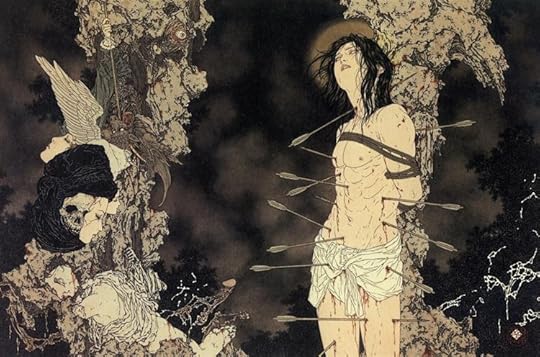 "Saint Sebastian"
"Saint Sebastian"by Takato Yamamoto
Today is the feast day of St. Sebastian, martyr. It's also inauguration day in DC. It's also the first day of my StoryGraph giveaway. Martin Luther King, too, look at that. With all this, I want to tell you about the definition of "martyr."
"The use of the word μάρτυς (mártys) in non-biblical Greek was primarily in a legal context. It was used for a person who speaks from personal observation. The martyr, when used in a non-legal context, may also signify a proclamation that the speaker believes to be truthful. The term was used by Aristotle for observations, but also for ethical judgments and expressions of moral conviction that can not be empirically observed. There are several examples where Plato uses the term to signify 'witness to truth,' including in Laws."Thanks, Wikipedia. So, this is the basis for the term used in Christianity.
Did you know that St. Sebastian's arrows did not kill him? The saint's martyrdom was not by the use of the arrows from the firing squad; he's normally depicted in art tied to a tree and speared with arrows, the Yamamoto image being a modern and rather unique take on the classic. Sebastian (255 - 288 CE) lived during the reign of Roman Emperors Diocletian and Maximian, born in Gallia Narbonensis (what's now Provence // Occitane in France) and educated in Milan. The young man rose to the rank of the Roman Praetorium Guard and so learned the ins and outs of the politics surrounding those emperors. Sebastian concealed his Christianity while secretly converting powerful families to the faith and performing miracles. He was found out and sentenced to death. After returning from what seemingly would have been death, however, he appeared before Diocletian as though he were a phantasm and righteously berated the emperor for genocide against the people of God, which then led to his being killed by means of clubbing.
Why is this relevant? Think. Think a lot.
There are many seers of truth. We're all meant for it. We offer you the truth but can't make you accept it. We don't have to die doing it. Though that is a serious reality in the world and no one should take it lightly. In all cases we do have to die to ourselves, however. I don't have to write pieces like "Knight Stalker." I can write like and adulate weirdgirl authors like M0na and Ott3ssa and Br0der. I can carry on like a Marxist like R00ney. They're making a lot. OK, good for them.
Why, though? Why would I do that when you need the truth? Do you think I could live with myself if I spewed out what's commercial, just so I can make money and gain attention? I've done that. I've looked into and experienced a life of extreme luxury and constant frivolous flattery. Being told you're meaningful when you're not. I was young and extremely naive. It doesn't lead to anything. You know that something is wrong and missing, something's being kept from you. I've known people who are stuck in that. They're not going anywhere except in a circle and they feel empty; the world teeters. Those people, unfortunately, because they feel deleted, seek to delete others. You can literally know in your bones that there is real suffering, and tell these people about it, or that there is salvation, and they're like:
"Oh my G0d, you literally think XXX? You're a XXX. You're brainwashed. You're a tool, you're an 0p." Where, no, I'm just me. And, you're just you. But, those people don't feel that they're "just me." They feel manipulated because they are, and, so, they assume you are too. Don't be manipulated!
How do you get out of the trap? You know it's a trap. So, just sit in the center of the tornado. Of the cyclone. When faced with the firing squad, let the arrows fly, knowing they will not kill you. You will, in the name of truth (or, God, if you really understand), come out the other side. You're meant to witness truth. The storm will pass. You will be reborn. You are meant for a beautiful life of discovery.
It won't be easy. It'll be lonely at times. You'll be tempted to think you're crazy. And, maybe, sometimes you'll be led astray, and maybe you'll find yourself a little crazy. Don't worry. You have another chance. Satan plays tricks on you, but, remember, she's awfully lonely herself and can't quite admit it.
Donald Trump is a convicted felon. Yes. We have a criminal for president. You have to calm down, though. If you think it's going to be the end of the world, then it will be the end of the world. I'm not saying he isn't going to make devastating decisions. I'm not saying he's great, but, I'm not saying he's the worst monster ever when we just came out of an administration that has bl00d on its hands and not just Gazan bl00d. Nope. Blood of patriots, too. This is a weird time.
My book? You think I'm exonerating RR or saying he's a victim? OK, I'm going to tell you a little of what happened in 2020: I was already writing a character with two of the same surnames, a character of the same race, in Los Angeles, in Boyle Heights, who could talk to spirits and was an extremely haunted young man, based also on an amalgamation of people I knew. When the algorithms gave me RR as I did research, I literally almost went insane. Believe me. I believed 99.9% that there was supernatural sh!t going on, because there were too many coincidences. I sweated bl00d with how scared I was, and also because of many other circumstances. I was tested. I had to witness things. I had to look at my own demon. Then, I had to realize that it's just a fallen angel; it's not God, or ultimate truth.
Yeah, I channeled something, but, if I had seen it as a curse I'd have fallen apart and died. That's how St. Sebastian might have thought, but, he didn't die by the arrows. RR isn't a martyr but I would say his victims are, and, I'm channeling something that is universal. It was handed to me, and I listened to the truth, I saw the truth, and I am giving it to you for $0.99! It's 45 pages. You can read it in an hour / hour and a half. Or more if you want to read it carefully. It's aged better than any Bordeaux. Believe me, I'm not looking to become Co11een Hoo\/er. I do not care about that. I care about you. I can tell you that Co11een most likely doesn't.
No one ever really dies the way we think they do. But, I've had to die a lot of times to my own self, to thinking that I know everything, to the disease of pointing the finger at everyone else and labeling everyone. If I can do it, you can. Truth-tellers do it. And when we least expect it, signs come that people have been saved by God through our truth-telling. That is better than what the weird litfic girls' careers are all about and the messages they're sending. This is not the time to read dumb things. This is time to have compassion for those writers who don't know what they're doing.
Reading "Knight Stalker" is a form of witnessing truth. I believe that you can handle it. I believe you can read the signs, decode it, think about it.
November 26, 2024
"Red Rooms" (2023/24): Truth Comes Down from Her Tower to Chastise Mankind
Title from the 1896 painting "Truth Coming Out from Her Well Armed with a Whip to Chastise Humanity (La Vérité sortant du puits armée de son martinet pour châtier l'humanité)" by Jean-León Gérôme.
She left the web, she left the loom She made three paces thro' the room She saw the water-flower bloom,She saw the helmet and the plume,
She look'd down to Camelot.
Out flew the web and floated wide;
The mirror crack'd from side to side;
'The curse is come upon me,' cried
The Lady of Shalott.
-- Lord Alfred Tennyson, 1832
Summary
Set in Montréal, Pascal Plante's 2023/24 "Red Rooms" -- which is a frightening enough title if you know about the dark web -- the film begins with an enigmatic character Kelly-Anne, a woman in her mid to late twenties, attending the trial of a serial murderer and rapist, Ludovic Chevalier, while seemingly having no personal involvement in the case. Chevalier is accused of a variety of heinous crimes surrounding his allegedly raping and torturing to death on livestream three teenage girls in exchange for money in the form of cryptocurrency on the dark web (using TOR, an online system of layering data so as to keep IP addresses and ISPs anonymous) in "red rooms." Red rooms, or sites on which rape/torture/murder may be livestreamed for a price, are urban legends. The reason they seemingly don't exist is that data is too slow to be processed through TOR, rendering any kind of discernable livestream impossible.
Chevalier's trial is to determine if, within the videos created and sold and found, the masked torturer/murderer is indeed Chevalier.
Kelly-Anne is a model who spends most of her days and nights in her high-rise apartment, with no friends or family, and who accrues even more income beyond her modeling (in bitcoin, one of the most well-known and frequently used forms of crypto, around which would exist the one hidden link between herself and the case) playing online poker. She's built her own AI, whom she's named Guenièvre. Arthurian motifs play a role in the film, Guenièvre and "Chevalier" (French for "knight") are already implied. Kelly-Anne is a stoic individual and idiosyncratic about health and fitness. She's incredibly skilled at hacking, navigating the web like the Arthurian Lady of Shalott weaves images in her tower.

Toward the end of the dramatic beginning of "Red Rooms" which depicts the commencement of Ludovic's trial, including statements from the judge and the prosecutor and the defense, we see Kelly-Anne (who'd slept on the street in front of the courthouse just so she could secure a spot in the courtroom, or at least we think that's why, but, perhaps she's compelled not to sleep in her own apartment as per the Lady of Shalott comparison) stare unabashedly and with alarming intensity at Chevalier, who is sitting alone and handcuffed within a bullet-proof booth of his own. Chevalier doesn't look up at anyone. The scene is arresting, with long continuous takes, particularly one lasting twelve minutes. The film itself is shot in the unusual aspect ratio of 1:50:1, a boxy outdated ratio used in VistaVision: this adds a sensation of seeing the events through human eyes.
Kelly-Anne takes interest in the mother of the one youngest victim, Camille, whose video has not been found by the authorities, and researches the woman and even hacks into her email to find the code to her home's lock system. What she'll do with this information we still don't know.
The protagonist is soon approached by a hybristophile fangirl who, like Kelly-Anne, has attended the trial every day, a young woman named Clémentine. Clémentine is unstable, having traveled a long distance to attend the trial of a man she deems innocent and framed, believing that as per Canadian law one is innocent until proven guilty. This kind of behavior is common in real life. Killers and more general criminals everywhere and for a long time have tended to have groupies who for various reasons feel romantically or sexually attracted to the idea of men who break basic rules. Maybe she can fix him. Maybe he's no longer a threat and can be romanticized for his depravity without risking being victim to that depravity. Maybe it's evolution, as aggressive and non-empathetic men mean "stronger animals" and better means of protection and strong genes to produce offspring with.

The two women can't be more different, as Clémentine is a fragile and even likeable delusional/psychotic mess who is desperare for help, a foil to Kelly-Anne in her cold and calculated manner and lifestyle and with her hideously unlikeable character traits. Nevertheless, Kelly-Anne for reasons still unknown invites Clémentine to her apartment to stay and the two bond as much as the unpalatable circumstances allow. Clémentine is impressed with Guenièvre, and laughs at Kelly-Anne's dark humor around remaking that she'd used to ask the AI as she was beta testing it whether she should commit suicide and it would reply "yes" until she trained it to value her person so that it now replies "no." It's mostly through the scenes with Clémentine that we viewers see Kelly-Anne's neurosis and her inability to socialize, though she has her warm moments. Unlike Clémentine, though, she doesn't romanticize Chevalier. At least not externally. Nevertheless, she religiously attends the trial every day with Clémentine until the day in which the videos of two of the victims are to be shown.
All except the jury, the lawyers and the accused, as well as the families of the victims, are asked by the judge to leave the courtroom. Clémentine is frustrated, wanting to see the footage for herself to prove that the masked man in the videos is indeed not Chevalier. Kelly-Anne with alarming confidence insists that the man's voice cannot be heard, implying she's seen the videos. Clémentine catches on and is shocked that Kelly-Anne has access to classified evidence.
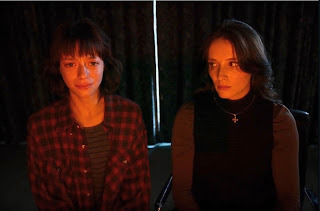
Here we learn that Kelly-Anne has already gained access through navigating the dark web to the videos and has never held doubt that Chevalier is the masked man and therefore guilty of the crimes he's on trial for. She's known the whole time what Chevalier has done. Kelly-Anne suggests Clémentine not see the videos but Clémentine insists. The poor girl suffers both from seeing the horrifying display of violence and witnessing that the man due to his stance and movements and a glimpse at his eyes through the mask is, indeed, her beloved Chevalier she wanted so badly to be innocent. Clémentine, despite having formed a kinship with Kelly-Anne, leaves Montréal, her last question to Kelly-Anne being, "what are you still doing here [implying the courthouse]?"
Without Clémentine, Kelly-Anne begins to spiral. Her career is compromised, and, in the meantime, we see her engaging in a chat with an anonymous seller on the dark web.
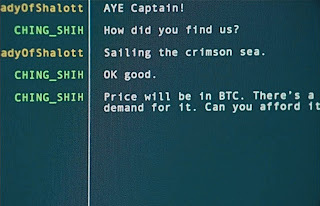
The creepiest, by far, and the most mysterious scene comes when Kelly-Anne steals a schoolgirl uniform from the school in which Chevalier's victims went, dons a blonde wig and carries fake braces, and goes to trial looking exactly like Camille. Even putting on blue contacts. While she's taken away from the courtroom by authorities is the only time Chevalier looks up at anyone throughout the entire film -- he looks up to her with sad-puppy eyes and waves while Kelly-Anne grins maniacally albeit triumphantly. She got his attention. She got the psychopath to react.
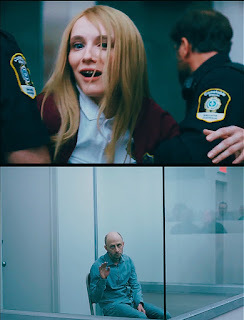
Kelly-Anne loses her modeling contract due to that stunt which went public, and then decides to further engage with the anonymous dark web seller who's selling the third and final of Chevalier's videos. The one of Camille. Kelly-Anne's username being "Lady0fShalott" we begin to understand that she might not so much be a hybristophile as much as a psychopath/sociopath who is encased in her own tower like the Arthurian Lady of Shalott, in her apartment, weaving "webs" until she is ensnared by real-life. In the Arthurian legends the weaving Lady with a mirror is drawn to the actual person of Lancelot in the romantic sense, in the case of Kelly-Anne the model/IT genius/hacker is drawn by another psychopath/sociopath and leaves her "tower" for him. The Lady of Shalott leaving her tower means she will die, as per a curse. The weaving and the mirror are metaphors for the dark web and the AI.
Frenzied, Kelly-Anne vies to purchase the video. Jumping through hoops, during which she realizes that the police is watching her due to the courtroom stunt she pulled and also having hacked Guenièvre to spy on her, she wins enough money to purchase the Camille video.
This scene is the second most disturbing after the Camille-impersonation scene in the courtroom, as when Kelly-Anne "wins" having paid the equivalent of $410k, she is in full mania and laughing, thrilled that she holds the key to the case.
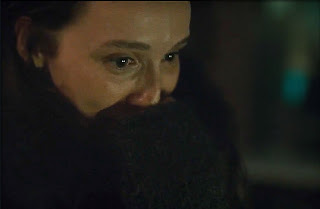
Like the Lady of Shalott, she leaves her tower, having destroyed Guenièvre, and enters Camille's mother's house with the lock code she learned, to leave the footage. This footage is irrefutable proof that Chevalier is the culprit, as he wears no mask in this video. But, as she breaks into Camille's house, she's once again dressed as the young victim. Though she doesn't make a sound as everyone is sleeping, she still walks around as though she herself were Camille, before leaving the footage on the bedroom's nighstand and drifting away... supposedly to kill herself. Within her own heart there's irrefutable proof that she is cursed by her own psychopathy/sociopathy. She's up against the prospect of facing the authorities for having purchased such a thing as the snuff film. She's now a twisted criminal herself, without recourse to hide and browse the web anonymously.
Kelly-Anne is the Lady of Shalott, and her desktop image is even of a painting of the legend.
Chevalier changes his plea to guilty and is handed life-imprisonment without parole.
The final scene shows Clémentine on the screen of one of Kelly-Anne's desktops, on a program in which she explains her delusional romantic obsession with the killer and her healing process from that, emphasizing that now her thoughts... are only with the victims and their families. Clémentine herself is somewhat a victim of a dangerous cultural obsession.
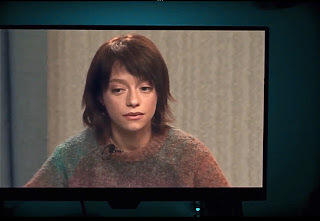
But given that we're to assume Kelly-Anne committed suicide, to what extent is she a victim? And, of what/whom?
Camelot Meets "A Midsummer Night's Dream" Meets Pyramus & Thisbe
Canada falls under the British Crown, after all, so, it would stand to reason that several English myths and classics would serve as symbols.
During one scene in which we viewers glimpse into Kelly-Anne's world, we see a conversation on the screen between Kelly-Anne as "Lady0fShalott" with another person whose username is "dungeo," engaging in a back-and-forth of lines from Shakespeare's "A Midsummer Night's Dream" which in itself is a comedy of errors blending fantasy with reality.
These lines are from the epilogue of Midsummer Night, in which the characters are putting on a play themselves (a play within a play) on the tragic story of star-crossed love from Ovid's "Metamorphosis" of Pyramus and Thisbe (this story inspired the plot of Shakespeare's "Romeo & Juliet"). The scene has to do with how the character of Moonshine speaks while not being the actual source of light, because the light of the moon is likened to a candle into which the cold dead moon would not merge with or else it burn. The moon wanes because it is at a distance from the candle, but, eventually, will get close enough to wax entirely. The character Moonshine thinks that all it shines on belongs to it, in the same way that the moon if it had self-awareness might think itself the source of light in ignorance that it only reflects the sun's light (while the sun may never be direcly gazed upon). For more on how moonlight has to do with megalomaniacal killers and the individuals who complement them for better or worse, please see my previous post moonlight and righteousness: death note and the killer egregore.
DEMETRIUSHe dares not come there for the candle; for, yousee, it is already in snuff.
HIPPOLYTAI am aweary of this moon: would he would change!
THESEUSIt appears, by his small light of discretion, thathe is in the wane; but yet, in courtesy, in allreason, we must stay the time.
LYSANDERProceed, Moon.
MOONSHINEAll that I have to say, is, to tell you that thelanthorn is the moon; I, the man in the moon; thisthorn-bush, my thorn-bush; and this dog, my dog.
DEMETRIUSWhy, all these should be in the lanthorn; for allthese are in the moon. But, silence! here comes Thisbe.
Enter Thisbe
THISBEThis is old Ninny's tomb. Where is my love?
LION[Roaring] Oh--
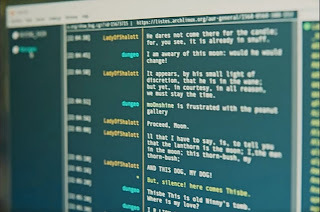
What matters just as much is the dialogue preceding these lines which don't feature in "Red Rooms:"
MOONSHINEThis lanthorn doth the horned moon present;--
DEMETRIUSHe should have worn the horns on his head.
THESEUSHe is no crescent, and his horns areinvisible within the circumference.
MOONSHINEThis lanthorn doth the horned moon present;Myself the man i' the moon do seem to be.
THESEUSThis is the greatest error of all the rest: the manshould be put into the lanthorn. How is it else theman i' the moon?
If the lantern is the digital world and Kelly-Anne the "man in the moon" it suggests that she should become one with the digital world entirely rather than exist outside it, and burn. As I said, she herself is a psychopathic criminal.
Also, the comment about how Moonshine (played by the character Starveling) should wear horns is a reference to the old image of a horned man being a cuckold or a man unaware that his wife is cheating while all else can clearly see, a naive and perhaps entitled man or just a plain fool. This squares with Guenièvre's witty joke-telling, particularly when Kelly-Anne is naive enough to think the police aren't on to her: "Why are ghosts such bad liars? ...Because they are so easy to see through."
The joke is on Kelly-Anne in the end, just like the joke's on the characters in Midsummer's Night, in Romeo & Juliet and in Pyramus & Thisbe. Therefore, we can say Kelly-Anne is victim to her hubris in thinking she could build her own world, her own artificial intelligence serving as a mirror, weave her way around the web, and not face the real world in which it's clear that her mind operates similar to that of a serial killer's.
Conclusion
I could speak about the madness of hybristophilia and the True Crime fandom, as well as on the psycho-spiritual implications of the digital world, but, I would rather you check out my short story available for $0.99 and see what I do with these very themes.
If not, then I offer up this book on Crime Library without analyzing it, by DeSales University professor of forensic psychology and criminal justice Katherine Ramsfeld, which covers a lot: Serial Killer Groupies.
Also, there are a lot of forums on which debates rage around whether "red rooms" do exist. This video, albeit creepy in nature, explains why they wouldn't exist.
REDRUM / MURDER -- STEPHEN KING'S SHINING
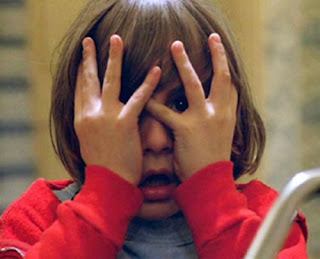
August 15, 2024
assumption // dormition //
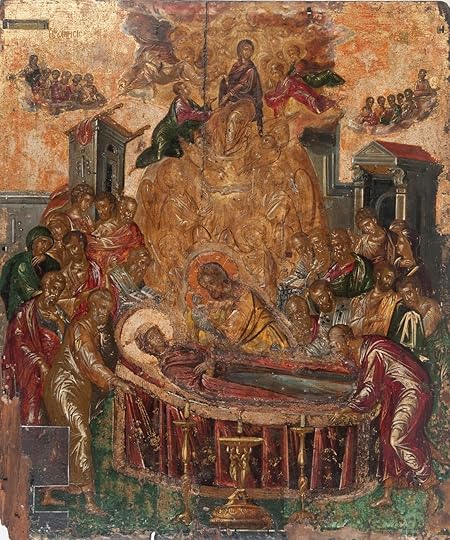
The Dormition (1565-66)
by El Greco in the Cathedral of the Dormition in Hermoupolis
A great sign appeared in the sky, a woman clothed with the sun, with the moon under her feet,
and on her head a crown of twelve stars. She was with child and wailed aloud in pain as she labored to give birth.
Then another sign appeared in the sky; it was a huge red dragon, with seven heads and ten horns, and on its heads were seven diadems. Its tail swept away a third of the stars in the sky and hurled them down to the earth.
Then the dragon stood before the woman about to give birth, to devour her child when she gave birth.
She gave birth to a son, a male child, destined to rule all the nations with an iron rod.
Her child was caught up to God and his throne. The woman herself fled into the desert
where she had a place prepared by God.
Then I heard a loud voice in heaven say: "Now have salvation and power come, and the Kingdom of our God and the authority of his Anointed One."
Reading II (1 Cor. 15:20-27)Brothers and sisters:
Christ has been raised from the dead, the firstfruits of those who have fallen asleep. For since death came through man, the resurrection of the dead came also through man. For just as in Adam all die, so too in Christ shall all be brought to life, but each one in proper order: Christ the firstfruits; then, at his coming, those who belong to Christ; then comes the end, when he hands over the Kingdom to his God and Father, when he has destroyed every sovereignty and every authority and power. For he must reign until he has put all his enemies under his feet. The last enemy to be destroyed is death, for "he subjected everything under his feet."
Reading III (Lk. 1:39-56)
Mary set out and traveled to the hill country in haste to a town of Judah, where she entered the house of Zechariah and greeted Elizabeth. When Elizabeth heard Mary’s greeting, the infant leaped in her womb, and Elizabeth, filled with the Holy Spirit, cried out in a loud voice and said,
"Blessed are you among women, and blessed is the fruit of your womb. And how does this happen to me, that the mother of my Lord should come to me? For at the moment the sound of your greeting reached my ears, the infant in my womb leaped for joy. Blessed are you who believed that what was spoken to you by the Lord would be fulfilled."
And Mary said: "My soul proclaims the greatness of the Lord; my spirit rejoices in God my Savior for he has looked with favor on his lowly servant. From this day all generations will call me blessed: the Almighty has done great things for me and holy is his Name. He has mercy on those who fear him in every generation. He has shown the strength of his arm, and has scattered the proud in their conceit. He has cast down the mighty from their thrones, and has lifted up the lowly. He has filled the hungry with good things, and the rich he has sent away empty. He has come to the help of his servant Israel for he has remembered his promise of mercy, the promise he made to our fathers, to Abraham and his children forever."
Mary remained with her about three months and then returned to her home.
Brahma Knowledge by L.D. Barnett, 1911:
VII The Soul in Sleep, p. 68-70;
(from Bṛihad-āraṇyaka Upanishad, IV, iii, 7-33)
"What is the Self?"
"It is the Spirit made of understanding among the Breaths, the inward light within the heart, that walks abroad, abiding the same, through both worlds. He meditates, as it were; He hovers about, as it were.
Turned to sleep, He passes beyond this world, the shapes of death. This Spirit at birth enters into the body, and is blent with evils; at death He passes out, and leaves evils.
Two seats has this Spirit, this and the seat in the world beyond 1; and midway is a third, the seat of dreams. Standing in this midway seat, He looks upon these two seats, this and the seat in the world beyond. Now as this is a step toward the seat in the world beyond, He makes this step and beholds both evils and delights.
When He sleeps, He takes matter from this all-containing world, Himself hews it down, Himself builds it up, and sleeps in His own brightness, His own light. Here the Spirit has Self for light. Therein are no cars, no car-teams, no roads; but He creates cars, car-teams, roads. Therein are no joys, mirths, merriments; but He creates joys, mirths, merriments. Therein are no pools, lakes, streams; but He creates pools, lakes, streams. For He is the maker…
When in this dreaming He has wantoned and wandered, and seen good and evil, He hastens back according to His entrance and His place to the bound of waking. He is followed by naught of all that He has seen there; for to this Spirit nothing clings…
When in this waking He has wantoned and wandered, and seen good and evil, He hastens back according to His entrance and His place to the bound of dreams. Even as a great fish passes along both banks, on this side and on yonder side, so this Spirit passes along both bounds, the bound of dreaming and the bound of waking.God's temple in heaven was opened, and the ark of his covenant could be seen in the temple.
assumption // dormition // how my short story ends if you pay attention

The Dormition (1565-66)
by El Greco in the Cathedral of the Dormition in Hermoupolis
A great sign appeared in the sky, a woman clothed with the sun, with the moon under her feet,
and on her head a crown of twelve stars. She was with child and wailed aloud in pain as she labored to give birth.
Then another sign appeared in the sky; it was a huge red dragon, with seven heads and ten horns, and on its heads were seven diadems. Its tail swept away a third of the stars in the sky and hurled them down to the earth.
Then the dragon stood before the woman about to give birth, to devour her child when she gave birth.
She gave birth to a son, a male child, destined to rule all the nations with an iron rod.
Her child was caught up to God and his throne. The woman herself fled into the desert
where she had a place prepared by God.
Then I heard a loud voice in heaven say: "Now have salvation and power come, and the Kingdom of our God and the authority of his Anointed One."
Reading II (1 Cor. 15:20-27)Brothers and sisters:
Christ has been raised from the dead, the firstfruits of those who have fallen asleep. For since death came through man, the resurrection of the dead came also through man. For just as in Adam all die, so too in Christ shall all be brought to life, but each one in proper order: Christ the firstfruits; then, at his coming, those who belong to Christ; then comes the end, when he hands over the Kingdom to his God and Father, when he has destroyed every sovereignty and every authority and power. For he must reign until he has put all his enemies under his feet. The last enemy to be destroyed is death, for "he subjected everything under his feet."
Reading III (Lk. 1:39-56)
Mary set out and traveled to the hill country in haste to a town of Judah, where she entered the house of Zechariah and greeted Elizabeth. When Elizabeth heard Mary’s greeting, the infant leaped in her womb, and Elizabeth, filled with the Holy Spirit, cried out in a loud voice and said,
"Blessed are you among women, and blessed is the fruit of your womb. And how does this happen to me, that the mother of my Lord should come to me? For at the moment the sound of your greeting reached my ears, the infant in my womb leaped for joy. Blessed are you who believed that what was spoken to you by the Lord would be fulfilled."
And Mary said: "My soul proclaims the greatness of the Lord; my spirit rejoices in God my Savior for he has looked with favor on his lowly servant. From this day all generations will call me blessed: the Almighty has done great things for me and holy is his Name. He has mercy on those who fear him in every generation. He has shown the strength of his arm, and has scattered the proud in their conceit. He has cast down the mighty from their thrones, and has lifted up the lowly. He has filled the hungry with good things, and the rich he has sent away empty. He has come to the help of his servant Israel for he has remembered his promise of mercy, the promise he made to our fathers, to Abraham and his children forever."
Mary remained with her about three months and then returned to her home.
Brahma Knowledge by L.D. Barnett, 1911:
VII The Soul in Sleep, p. 68-70;
(from Bṛihad-āraṇyaka Upanishad, IV, iii, 7-33)
"What is the Self?"
"It is the Spirit made of understanding among the Breaths, the inward light within the heart, that walks abroad, abiding the same, through both worlds. He meditates, as it were; He hovers about, as it were.
Turned to sleep, He passes beyond this world, the shapes of death. This Spirit at birth enters into the body, and is blent with evils; at death He passes out, and leaves evils.
Two seats has this Spirit, this and the seat in the world beyond 1; and midway is a third, the seat of dreams. Standing in this midway seat, He looks upon these two seats, this and the seat in the world beyond. Now as this is a step toward the seat in the world beyond, He makes this step and beholds both evils and delights.
When He sleeps, He takes matter from this all-containing world, Himself hews it down, Himself builds it up, and sleeps in His own brightness, His own light. Here the Spirit has Self for light. Therein are no cars, no car-teams, no roads; but He creates cars, car-teams, roads. Therein are no joys, mirths, merriments; but He creates joys, mirths, merriments. Therein are no pools, lakes, streams; but He creates pools, lakes, streams. For He is the maker…
When in this dreaming He has wantoned and wandered, and seen good and evil, He hastens back according to His entrance and His place to the bound of waking. He is followed by naught of all that He has seen there; for to this Spirit nothing clings…
When in this waking He has wantoned and wandered, and seen good and evil, He hastens back according to His entrance and His place to the bound of dreams. Even as a great fish passes along both banks, on this side and on yonder side, so this Spirit passes along both bounds, the bound of dreaming and the bound of waking.God's temple in heaven was opened, and the ark of his covenant could be seen in the temple.
August 11, 2024
the buddhism of madoka & the madness of faust
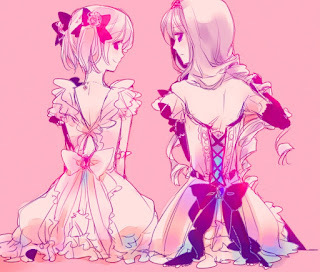 "Puella Magi Madoka Magica: Walpurgisnacht Rising," Early Winter 2025
"Puella Magi Madoka Magica: Walpurgisnacht Rising," Early Winter 2025Puella Magi Madoka Magica is a 2011 anime series of twelve episodes, which in 2012/13 were condensed into two feature films and given a glossy well-produced third installment called "Rebellion." A fourth film is being released "soon."
Its world in the fake Japanese city Mitakihara consists of magical girls or "mahō shōjo" (a trope in manga/anime) whom each make a contract with an Incubator named Kyūbey. This results not only in a single wish being granted but in a compulsion to fight and kill entities called "witches" which bring disaster through invisible labyrinths. Witches' labyrinths trap innocent people and cause them to harm themselves and others. We learn as the story progresses that witches were once magical girls who at some point turned to despair. They turned to despair for a variety of reasons. Due to finding out the devastating truth that all witches were indeed once magical girls, or because their wishes ended up causing more harm than good. Both and then some. A magical girl runs out of magic if she doesn't purify her "soul gem" (which is the locus of her mind-soul or kokoro, rather than it being in her body which is more like an empty shell used for combat). She purifies her soul gem with "grief seeds" she collects from defeating witches. The grief seeds of witches were once soul gems. See the cycling? It's this violent transformation of a hopeful magical girl into a witch that Kyūbey curates into energy. This energy is used to maintain the universe. Apparently, the universe is running out of heat due to entropy (or the idea that destruction is quicker than creation and therefore superior, and so time is not on the side of maintaining life).
A lonely and ill girl named Homura wished to turn back time to once more meet her best friend Madoka (a magical girl) after Madoka dies defeating a witch called Walpurgisnacht. Homura therefore possesses the power to time-travel. When she turns back one loop of time, she discovers the secret of the Incubator when instead of Madoka dying by the shattering of her soul gem she's rather turned into a witch by using up too much magic fighting Walpurgisnacht and caving to despair. Homura repeats the loop again. And again. And again and again and no matter that Madoka continues making a contract with the Incubator and becoming an ever-more powerful witch. The truth is that Homura makes Madoka a more powerful magical girl, and therefore a more powerful witch inevitably, by looping back time as often as she does. Homura doesn't realize that her own power is of the same nature -- and, so, has the same effect -- as the cycling of magical girls needing to defeat witches until they become witches themselves the more fruitless their endeavors become.
And, that's the tragic story.
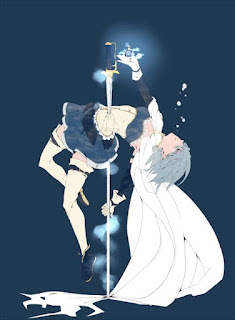
Until Madoka breaks the cycle in the hundredth time-line. Madoka rewrites the universe given how powerful her karma is, and becomes a principle with which any and all magical girls in existence (past, present and future) never become witches but rather die peacefully. Madoka becomes a kind of goddess. In order for this accomplishment, Madoka must disappear from any and all timelines and anyone's memory except Homura's (naturally, since Homura gave her the karma in the first place.). Witches no longer exist and what magical girls fight in exchange for their wishes are entities called wraiths. The anime ends there and we're all a little sad but hopeful.
Until "Rebellion."
In "Rebellion" Homura has made an awful mistake of revealing to the memory-erased Incubator the truth of what had once occurred. Boo. This causes the Incubator to wonder whether or not "trapping" Madoka (now called "the Law of Cycles") can reverse Madoka's deification and return the universe to its original state where magical girls become witches. Kyūbey accomplishes this by using Homura's soul gem. Homura is exhausted and ready to die, but Kyūbey creates a barrier between her body and soul gem, and Homura is none the wiser. Kyūbey allows through the barrier foreign entities to enter the "labyrinth" being created by Homura's darkening soul gem, but doesn't allow anyone out. This is in order to catch the Law of Cycles (Madoka). Homura's and Madoka's friends, including three other beloved magical girls Mami and Sayaka and Kyōko, along with some other characters, enter the soul-gem-labyrinth and participate in Homura's fantasy of what a perfect world would be like. The entities she and the other girls fight are called Nightmares, and they're fairly easy to defeat. Things are peaceful, everyone is happy, but Homura figures something is strange. The world is shadowy, and she soon realizes that nothing exists outside of Mitakihara. Poor Homura goes through a grueling process of discovering the Incubator's plan, and that the world she's living in is her soul gem with actual people drawn into it. The labyrinth is formed, and Kyūbey practically orgasms. Finally, the demon-creature can identify who the Law of Cycles is: Madoka, who has no record of ever existing in anyone's memory in any universe. Madoka's there to bring peace to Homura as she dies, manifesting as the sweet girl Homura remembers her as. Sayaka and another magical girl Charlotte remind Madoka that she's a "goddess" and everyone helps Homura break through the Incubator's barrier so that the demon-creature may avoid catching Madoka. Everything returns to the world in which magical girls die a peaceful death, and goddess Madoka reaches out to bring Homura to blissful death.
Until Homura becomes the Devil.
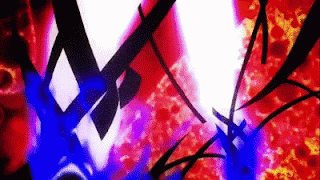
Homura is just as powerful as Madoka, if not more. She gave Madoka all the power in the first place, no? In the original universe in which magical girls turn to witches? She created Madoka's power with her loops and Madoka made her choice. So... Homura decides to do as Madoka does and create her own world, in which "good intentions" and "self-sacrifice" are thwarted. Most importantly, in Homura's universe, a meek human version of Madoka exists. Madoka resembles the original Homura, awkward and alienated, and Homura is strong. The Law of Cycles still exists. But, Homura has her cake and eats it too. Madoka's godhood remains, and Homura's godhood exists to tempt Madoka out of remembering her godhood so as to hold her forever or some shit. Kyūbey is now a slave to Homura and aids magical girls in defeating wraiths.
Is it Sapphic? It's fetishy. But, I don't think it's as Sapphic as much as it is platonically combative. Schoolgirls as God and the Devil, who each have equal footing. It's dualistic, definitely not truly Christian. Although, it is Calvin-y Christian. But, are Calvinists Christians? Ehhh... Iiiaaayyy... don't... know... Double predestination is a dualistic concept that doesn't square well with the idea of a loving God. Double predestination (not to be confused with double penetration heh 😈) is basically the tenet that some people are destined for Hell no matter what. So, there's no use in "doing good." What kind of God are Calvinists and all the churches that have emerged from Calvinism worshiping? Sounds more like a Devil than a loving God. In the more sophisticated traditions of Christianity, we believe that evil has no rights and no footing in nature. God doesn't make evil. Evil exists existentially. Our actions can be inherently evil, but human actions are not God's doing. God is the source of all being and truth; He's not a "thing" but rather creates things and nothing He creates is evil. Human actions are evil, and those are not things (existents). And all the weird stuff pre-Christ in the Old Testament must be read symbolically and allegorically, otherwise we'd be worshipping a Nero-like genocidal angry and envious God.
That's why I am an atheist in the name of God.

Back to 2024.
Homura's loops and her relationship with the Incubator equate to an excellent retelling of Goethe's Faust. Faust represents lunatic obsession with accomplishing that which cannot in good conscience (and therefore, not rationally) be accomplished by virtue of a pact with a spirit who, if you're not happy in the end, you become a slave to. As mentioned, it's dualistic, and while dualism in Christianity sucks it makes more sense in Buddhism. Desire = suffering; inevitability = unmoving; awareness = liberation; detachment = bliss; compassion = divinity. Madoka achieved enlightenment by accepting the inevitability of suffering, by detaching from her own selfish desires, and in her compassion found her fate in existing as a deity to lead others of her kind to similar enlightenment (except for Homes, who did the opposite).
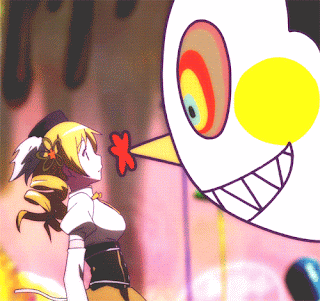
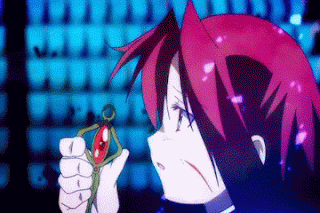
But, what about Walpurgisnacht? Walpurgisnacht is German for "Night of St. Walpurga" which in Faust is represented by a kind of witch festival (though it used to be in real life more of a harvest festival). Who is Walpurgisnacht in Puella Magi Madoka Magica?
Watch the imagery, while I've provided transcripts of the words appearing and being spoken.
Written (what seems to be Homura's thoughts and memories): WALPURGISNACHTOfficial name: Stage Witch (Unknown)Its nature is helplessness.The symbol of a fool who spins around and around.The legend of a mysterious witch that has been passed down...from generation to generation throughout history,
A mahō shōjo's worst and most powerful enemy,CALAMITY.
In the past, this "existence" brought hope,and eventually scatters curses.The Law of Cycles saved us.
I want to see you one more time.
The world is for Madoka!
Spoken :[telephone][call answered]Can you accept the risks and responsibilities?Can you fight against the curse of this world?
It's a secret, a secret.Don't tell anyone.There's one thing you must do.
That's love.What nonsense.Devil.A mahō shōjo I don't know.
Bring hope.Just bring hope.Goodbye.
Release that girl.Homura-chan, my best friend.[click]
And so, let the curtain rise on tonight's dream.And so, let the curtain rise on tonight's dream.
I don't have theories, but I have some impressions and guesses. There was a side story series called "Magia Record" which isn't worth mentioning except for the concept that a magical girl can create a "doppel" or a mirror image of what her witch form would look like.
Perhaps Homura becomes the once-unbeatable Walpurgisnacht in her own new universe so as to lure Madoka away from the humble and happy human life she's leading (which was Homura's doing, anyway, go figure) and toward her godhood so they can battle to the death.
Or, better, lure Madoka toward becoming a witch herself.
Maybe Homura's doppel is Walpurgisnacht.
What's with all those files and papers? That is, albeit, how it feels to be a graduate student lol.
HOWEVER, I FORGOT THIS AND THIS SEEMS LIKE THE KEY TO EVERYTHING: Homura had, in the third loop, almost turned into a witch with Madoka and said "let's burn down this world together, because it's not worth saving," until Madoka cleaned her soul-gem and prompted her to go back in time and stop her from making the contract with the Incubator.
Are we going to talk about Madoka's manipulation of Homura, compelling her to go back and back, because Madoka said "don't allow me to be stupid and get tricked by Kyūbey again"?
Who 👏 is 👏 the 👏 real 👏 Devil?

August 6, 2024
feast day 6 aug 2024 of the transfiguration
 MARK 9
MARK 9And he said to them, "Truly I tell you, some who are standing here will not taste death before they see that the kingdom of God has come with power."
The TransfigurationAfter six days Jesus took Peter, James and John with him and led them up a high mountain, where they were all alone. There he was transfigured before them. His clothes became dazzling white, whiter than anyone in the world could bleach them. And there appeared before them Elijah and Moses, who were talking with Jesus.
Peter said to Jesus, "Rabbi, it is good for us to be here. Let us put up three shelters—one for you, one for Moses and one for Elijah." (He did not know what to say, they were so frightened.)
Then a cloud appeared and covered them, and a voice came from the cloud: "This is my Son, whom I love. Listen to him!"
Suddenly, when they looked around, they no longer saw anyone with them except Jesus.
As they were coming down the mountain, Jesus gave them orders not to tell anyone what they had seen until the Son of Man had risen from the dead. They kept the matter to themselves, discussing what "rising from the dead" meant.
And they asked him, "Why do the teachers of the law say that Elijah must come first?"
Jesus replied, "To be sure, Elijah does come first, and restores all things. Why then is it written that the Son of Man must suffer much and be rejected? But I tell you, Elijah has come, and they have done to him everything they wished, just as it is written about him."
Jesus Heals a Boy Possessed by an Impure SpiritWhen they came to the other disciples, they saw a large crowd around them and the teachers of the law arguing with them. As soon as all the people saw Jesus, they were overwhelmed with wonder and ran to greet him.
"What are you arguing with them about?" he asked.
A man in the crowd answered, "Teacher, I brought you my son, who is possessed by a spirit that has robbed him of speech. Whenever it seizes him, it throws him to the ground. He foams at the mouth, gnashes his teeth and becomes rigid. I asked your disciples to drive out the spirit, but they could not."
"You unbelieving generation," Jesus replied, "how long shall I stay with you? How long shall I put up with you? Bring the boy to me."
So they brought him. When the spirit saw Jesus, it immediately threw the boy into a convulsion. He fell to the ground and rolled around, foaming at the mouth.
Jesus asked the boy's father, "How long has he been like this?"
"From childhood," he answered. "It has often thrown him into fire or water to kill him. But if you can do anything, take pity on us and help us."
"'If you can'?" said Jesus. "Everything is possible for one who believes."
Immediately the boy's father exclaimed, "I do believe; help me overcome my unbelief!"
When Jesus saw that a crowd was running to the scene, he rebuked the impure spirit. "You deaf and mute spirit," he said, "I command you, come out of him and never enter him again."
The spirit shrieked, convulsed him violently and came out. The boy looked so much like a corpse that many said, "He's dead." But Jesus took him by the hand and lifted him to his feet, and he stood up.
After Jesus had gone indoors, his disciples asked him privately, "Why couldn't we drive it out?"
He replied, "This kind can come out only by prayer."
Jesus Predicts His Death a Second TimeThey left that place and passed through Galilee. Jesus did not want anyone to know where they were, because he was teaching his disciples. He said to them, "The Son of Man is going to be delivered into the hands of men. They will kill him, and after three days he will rise." But they did not understand what he meant and were afraid to ask him about it.
They came to Capernaum. When he was in the house, he asked them, "What were you arguing about on the road?" But they kept quiet because on the way they had argued about who was the greatest.
Sitting down, Jesus called the Twelve and said, “Anyone who wants to be first must be the very last, and the servant of all."
He took a little child whom he placed among them. Taking the child in his arms, he said to them, "Whoever welcomes one of these little children in my name welcomes me; and whoever welcomes me does not welcome me but the one who sent me."
Whoever Is Not Against Us Is for Us"Teacher,” said John, we saw someone driving out demons in your name and we told him to stop, because he was not one of us."
"Do not stop him," Jesus said. "For no one who does a miracle in my name can in the next moment say anything bad about me, for whoever is not against us is for us. Truly I tell you, anyone who gives you a cup of water in my name because you belong to the Messiah will certainly not lose their reward."
Causing to Stumble"If anyone causes one of these little ones—those who believe in me—to stumble, it would be better for them if a large millstone were hung around their neck and they were thrown into the sea. If your hand causes you to stumble, cut it off. It is better for you to enter life maimed than with two hands to go into hell, where the fire never goes out. And if your foot causes you to stumble, cut it off. It is better for you to enter life crippled than to have two feet and be thrown into hell. And if your eye causes you to stumble, pluck it out. It is better for you to enter the kingdom of God with one eye than to have two eyes and be thrown into hell, where
'the worms that eat them do not die, and the fire is not quenched.'
Everyone will be salted with fire.
"Salt is good, but if it loses its saltiness, how can you make it salty again? Have salt among yourselves, and be at peace with each other."



